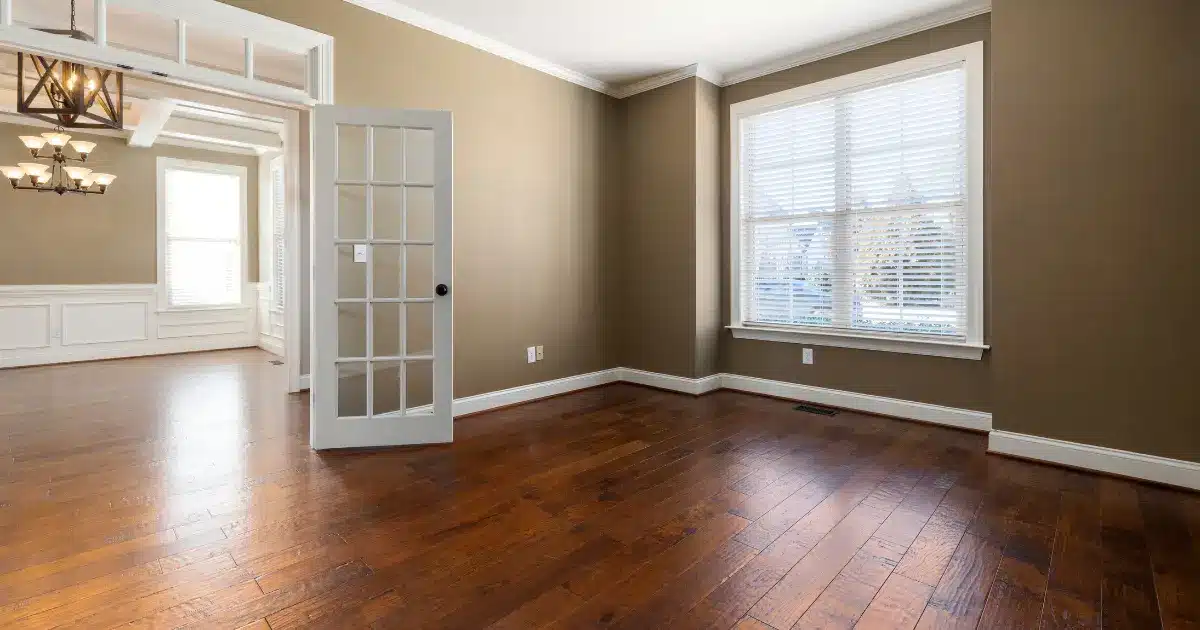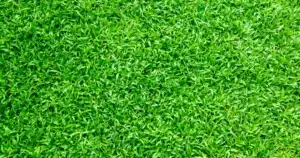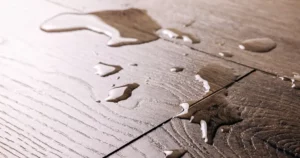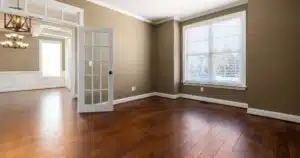What if your floors could blend century-old charm with tomorrow’s trends? In 2025, red oak flooring is rewriting the rules of interior design—no longer just your grandmother’s hardwood, but the secret weapon of modern renovators. With its fiery grain patterns dancing under matte finishes and planks wide enough to showcase nature’s artistry, this timeless material is staging a bold comeback. From Pinterest-perfect kitchens to cozy minimalist bedrooms, discover why designers are ditching cold alternatives for red oak’s warm embrace. This isn’t just flooring—it’s your home’s new legacy.
What Is Red Oak Flooring?
Red oak (Quercus rubra) is a domestic hardwood native to North America, prized for its strength, distinctive grain patterns, and warm reddish undertones. Here’s why it stands out:
- Appearance: Features pronounced grain lines, knots, and color variations, creating a rustic yet refined look.
- Durability: Scores 1290 on the Janka hardness scale, making it resistant to everyday wear and suitable for high-traffic areas.
- Versatility: Accepts stains exceptionally well, allowing customization from light natural tones to rich espresso finishes.
Why Choose Red Oak Flooring?
Red Oak remains a popular flooring choice for several reasons:
- Aesthetic Versatility: Its neutral tones complement both traditional and modern interiors.
- Affordability: Generally more cost-effective than other hardwoods like White Oak or Walnut.
- Availability: Abundant supply in North America ensures consistent quality and pricing.
- Ease of Refinishing: Can be sanded and refinished multiple times, extending its lifespan.
2025 Design Trends Featuring Red Oak
Let’s talk about what’s trending this year when it comes to Red Oak flooring. Whether you’re renovating your home or just browsing for ideas, these trends are shaping how homeowners and designers are using Red Oak in 2025 — and honestly, I’m loving the direction it’s going.
1. Wider Planks
One of the biggest trends we’re seeing? Wider planks (typically 6 inches or more). And trust me, they make a difference. They give your floors this really open, airy feel — kind of like your space just took a deep breath. If you’ve got a room with good natural light, wider planks help amplify that brightness while also making the grain pattern of Red Oak stand out beautifully. Whether you go with a rustic look or something more modern, wide planks bring a relaxed yet refined vibe to any space.
2. Matte and Natural Finishes
Glossy floors are taking a back seat this year. What’s really stealing the spotlight are matte and natural oil finishes. Why? Because they’re not just stylish — they’re practical too. Matte finishes give off a low-key elegance that feels warm and lived-in, without being too flashy. And if you’ve got kids, pets, or, let’s be real, just a busy life — matte is great for hiding the everyday scuffs and scratches. Natural oil finishes, on the other hand, bring out the raw beauty of Red Oak. You get that earthy, organic look that’s so on trend right now — and it’s easy to maintain, too.
3. Sustainable Choices
If you’re anything like me, you’re trying to make more environmentally-conscious decisions — and flooring is no exception. More and more homeowners are leaning into sustainably sourced Red Oak flooring. Look for certifications like the Forest Stewardship Council (FSC) when shopping. Red Oak is already a North American species, so you’re not shipping in exotic wood from halfway across the world. That’s a win for your home and the planet.
4. Mixed Width Installations
width planks are making a huge comeback. Mixing different widths in your flooring layout adds texture, depth, and a bit of that artisan touch. It’s especially cool in open floor plans where you want your flooring to make a quiet but confident design statement. You can go subtle with just two widths, or go bold with three or more. Either way, it’s a great way to showcase the natural charm of Red Oak while giving your space a handcrafted feel.
Red Oak vs. White Oak: What’s the Difference?
| Feature | Red Oak | White Oak |
| Color | Warm, reddish undertones | Cooler, gray-beige tones |
| Grain | Bold, varied patterns | Straight, uniform grain |
| Moisture Resistance | Moderate (open grain) | High (closed grain) |
| Cost | 3–11/sq. ft. (more affordable) | 4–12/sq. ft. |
White oak excels in moisture-prone areas, while red oak offers better stain versatility and budget-friendly pricing
Solid vs. Engineered Red Oak
- Solid Red Oak: Ideal for above-grade installations; can be sanded 3–5 times for decades of use. Moreover, it is made from a single piece of wood, and is more susceptible to moisture changes. Best for living rooms and bedrooms.
- Engineered Red Oak: Comprises a real wood veneer over plywood layers, offering better stability and moisture resistance, ideal for basements or over concrete slabs.
Styling Tips for Red Oak Flooring
Let’s talk style. Once you’ve got that gorgeous Red Oak floor installed, how do you make the rest of your room complement it? Here are a few of my favorite tips:
Wall Colors
Red Oak has warm undertones, so pairing it with neutral wall colors like soft gray, creamy white, or warm beige really helps it pop. These colors don’t compete with the wood’s natural beauty — they enhance it. If you want a more dramatic look, try a deep navy or forest green for contrast.
Furniture Pairing
When it comes to furniture, balance is key. You can go for wood tones that match the warmth of Red Oak, or create contrast with cooler finishes like black or gray. Mid-century modern pieces look amazing with Red Oak, but honestly, this wood is so versatile it pairs beautifully with almost any decor style.
Area Rugs
Don’t underestimate the power of a good rug! Area rugs are perfect for defining spaces, especially if you have an open-concept layout. They add softness underfoot and bring in layers of texture and pattern that make a room feel complete — and cozy.
Lighting
Last but definitely not least — lighting. Red Oak’s grain and color shifts depending on the light, so make sure your room has ample natural light or well-placed fixtures to show off those beautiful tones and textures. A well-lit Red Oak floor looks absolutely stunning.
Maintenance and Care
Proper maintenance ensures the longevity and beauty of Red Oak flooring:
- Regular Cleaning: Sweep or vacuum regularly to remove dirt and debris.
- Damp Mopping: Use a damp mop with a hardwood floor cleaner; avoid excessive water to prevent damage.
- Protective Measures: Place mats at entryways, use furniture pads, and avoid high heels to minimize scratches and dents.
- Refinishing: Depending on wear, consider refinishing the floor every 7-10 years to restore its original luster.
Cost Considerations in 2025
- Material Costs: Red Oak flooring ranges from $3 to $10 per square foot for materials.
- Installation Costs: The average total installed cost falls between $12.95 and $16.42 per square foot.
- Factors Influencing Price: Grade (select, #1 common, #2 common), plank width, finish (unfinished, prefinished), thickness (solid vs. engineered), and installation complexity all affect pricing.
| Type | Material Cost (per sq. ft.) | Installed Cost (per sq. ft.) |
| Solid Red Oak | $3–$11 | $6–$18 |
| Engineered Red Oak | $4–$10 | $8–$20 |
Prices vary by grade, finish, and region
Sustainability Aspects
Choosing Red Oak flooring can be an environmentally responsible decision:
- Renewable Resource: Red Oak is abundant and regenerates relatively quickly compared to exotic hardwoods.
- Local Sourcing: Being native to North America, it reduces transportation emissions and supports local economies.
- Certifications: Look for products certified by organizations like the Forest Stewardship Council (FSC) to ensure sustainable harvesting practices.
Why Choose Red Oak Flooring? The Pros:
- Timeless aesthetic that suits various interior styles.
- Durable and long-lasting with proper care.
- Versatile in terms of staining and finishing options.
- Generally more affordable than other hardwoods.
Why Not Choose Red Oak Flooring? The Cons:
- Slightly softer than some hardwoods, making it more susceptible to dents.
- More porous, requiring careful sealing to prevent moisture damage.
- Pronounced grain may not appeal to those seeking a smoother appearance.
Final Thoughts
Red Oak flooring continues to be a reliable and stylish choice for homeowners in 2025. Its adaptability to current design trends, combined with its inherent qualities, makes it a flooring option that balances aesthetics, functionality, and value.
Ready to transform your home with the warmth and elegance of Red Oak flooring? At Rogers Family Flooring, we offer a wide selection of Red Oak products to suit every style and budget. Our experts are here to guide you through the selection and installation process, ensuring a seamless experience from start to finish.





